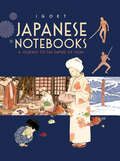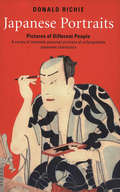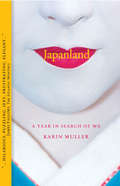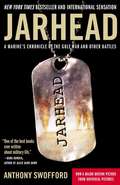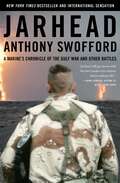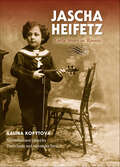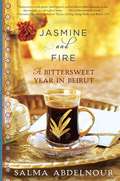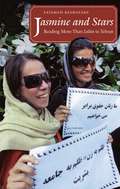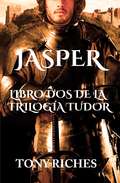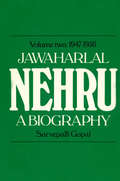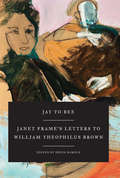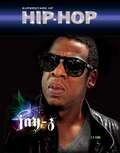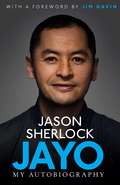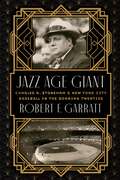- Table View
- List View
Japanese Farm Food
by Nancy Singleton HachisuThis award-winning cookbook offers a unique look at life on a Japanese farm through 165 recipes, personal stories and stunning photographs.American born and raised, Nancy Singleton Hachisu lives with her husband and sons on a rural Japanese farm, where they prepare these 165 bright, seasonal dishes. Covering everything from pickles and soups to noodles, rice, and dipping sauces, with a special emphasis on vegetables, Hachisu demystifies the rural Japanese kitchen, laying bare the essential ingredients, equipment, and techniques needed for Japanese home cooking.Combining stories and recipes, Japanese Farm Food is about food, family, and community. More than 350 vibrant images by Kenji Miura evoke the beautiful Japanese countryside and life on a traditional farm. With a focus on fresh and thoughtfully sourced ingredients, the recipes in Japanese Farm Food are perfect for fans of farmers’ markets, and for home cooks looking for accessible Japanese dishes.Gourmand World Cookbook Awards 2012: USA Winner, Best Japanese Cuisine Book
Japanese Notebooks: A Journey to the Empire of Signs
by Igort&“An insightful book . . . It&’s a fascinating glimpse into the traditions of Manga, and a thoughtful meditation on Japanese culture.&” —Starburst Magazine Japan is a place of special fascination for the acclaimed international comics creator Igort, who has visited and lived there more than twenty times, and worked in the country&’s manga industry for more than a decade. In this masterful new book—part graphic memoir, part cultural meditation—Igort vividly recounts his personal experiences in Japan, creating comics amid the activities of everyday life, and finding inspiration everywhere: in nature, history, custom, art, and encounters with creators including animation visionary Hayao Miyazaki. With beautifully illustrated reflections on subjects from printmaking to Zen Buddhism, imperial history to the samurai code, Japanese film, literature, and manga, this is a richly rewarding book for anyone interested in Japan or comic arts practiced at the highest level. &“Igort&’s memoir is a rich, complicated meditation on art, cultural infatuation and the seen versus the remembered, all told in a collage of words, images, diagrams, photographs, history, ideas, feelings—and most surprisingly—of conflict.&” —Chris Ware, author of Jimmy Corrigan: The Smartest Kid on Earth &“Drawn with precise yet densely lavish style, it balances comic interludes, stranger-in-a-strange-land parables, and side essays on notable writers, filmmakers, and madmen. It&’s an almost overpoweringly lush book that manages to simultaneously romanticize a foreign culture and lampoon that romanticization.&” —The Boston Globe &“A captivating glimpse into the mind of an artist.&” —Booklist (starred review)
Japanese Portraits
by Donald RichieThe private collections of longtime Japan resident Donald Richie capture the personalities of certain Japanese people--some famous, some unknown--with insight and humor. Richie, who considers himself a foreigner despite living in Japan for over 53 years, is a keen observer of human nature. In Japanese Portraits, he provides an elegant and perceptive vision of Japan through precise, intimate portraits of ordinary and extraordinary Japanese people. Portraits include such notable Japanese as acclaimed filmmakers Akira Kurowasa and Yasujiro Ozu, famed novelist Yukio Mishima, and celebrated actor Toshiro Mifune.
Japanland: A Year in Search of Wa
by Karin MullerDuring a year spent in Japan on a personal quest to deepen her appreciation for such Eastern ideals as commitment and devotion, documentary filmmaker Karin Muller discovered just how maddeningly complicated it is being Japanese. In this book Muller invites the reader along for a uniquely American odyssey into the ancient heart of modern Japan. Broad in scope and deftly observed by an author with a rich visual sense of people and place, Japanland is as beguiling as this colorful country of contradictions.
Jarhead: A Marine's Chronicle of the Gulf War and Other Battles
by Anthony SwoffordThe author weaves his experiences in war with vivid accounts of boot camp, reflections on the mythos of the marines, and remembrances of battles with lovers and family.
Jarhead: A Marine's Chronicle of the Gulf War and Other Battles
by Anthony SwoffordAnthony Swofford's Jarhead is the first Gulf War memoir by a frontline infantry marine, and it is a searing, unforgettable narrative. When the marines -- or "jarheads," as they call themselves -- were sent in 1990 to Saudi Arabia to fight the Iraqis, Swofford was there, with a hundred-pound pack on his shoulders and a sniper's rifle in his hands. It was one misery upon another. He lived in sand for six months, his girlfriend back home betrayed him for a scrawny hotel clerk, he was punished by boredom and fear, he considered suicide, he pulled a gun on one of his fellow marines, and he was shot at by both Iraqis and Americans. At the end of the war, Swofford hiked for miles through a landscape of incinerated Iraqi soldiers and later was nearly killed in a booby-trapped Iraqi bunker. Swofford weaves this experience of war with vivid accounts of boot camp (which included physical abuse by his drill instructor), reflections on the mythos of the marines, and remembrances of battles with lovers and family. As engagement with the Iraqis draws closer, he is forced to consider what it is to be an American, a soldier, a son of a soldier, and a man. Unlike the real-time print and television coverage of the Gulf War, which was highly scripted by the Pentagon, Swofford's account subverts the conventional wisdom that U.S. military interventions are now merely surgical insertions of superior forces that result in few American casualties. Jarhead insists we remember the Americans who are in fact wounded or killed, the fields of smoking enemy corpses left behind, and the continuing difficulty that American soldiers have reentering civilian life. A harrowing yet inspiring portrait of a tormented consciousness struggling for inner peace, Jarhead will elbow for room on that short shelf of American war classics that includes Philip Caputo's A Rumor of War and Tim O'Brien's The Things They Carried, and be admired not only for the raw beauty of its prose but also for the depth of its pained heart.
Jarhead: A Solder's Story of Modern War
by Anthony SwoffordA harrowing yet inspiring portrait of a tormented consciousness struggling for reconciliation and peace, JARHEAD is authentic, revelatory and brilliantly crafted. Anthony Swofford's grandfather fought in WWII; his father fought in Vietnam; and he - a directionless, testosterone-battered teenager - became a scout/sniper in the marines and fought in the Gulf War. His account of that time is also part of a lineage - after Wilfred Owen, Norman Mailer, Michael Herr and Tim O'Brien, it brings the raw and searing tradition of soldiers' stories up to date.
Jascha Heifetz: Early Years in Russia (Russian Music Studies)
by Galina KopytovaNotoriously reticent about his early years, violinist Jascha Heifetz famously reduced the story of his childhood to "Born in Russia. First lessons at 3. Debut in Russia at 7. Debut in Carnegie Hall at 17. That's all there is to say." Tracing his little-known upbringing, Jascha Heifetz: Early Years in Russia uncovers the events and experiences that shaped one of the modern era's most unique talents and enigmatic personalities. Using previously unstudied archival materials and interviews with family and friends, this biography explores Heifetz's meteoric rise in the Russian music world—from his first violin lessons with his father, to his studies at the St. Petersburg Conservatory with the well-known pedagogue Leopold Auer, to his tours throughout Russia and Europe. Spotlighting Auer's close-knit circle of musicians, Galina Kopytova underscores the lives of artists in Russia's "Silver Age"—an explosion of artistic activity amid the rapid social and political changes of the early 20th century.
Jasmine and Fire: A Bittersweet Year in Beirut
by Salma AbdelnourAs Beirut exploded with the bombs and violence of a ruthless civil war in the '80s, a nine-year-old Salma Abdelnour and her family fled Lebanon to start a new life in the States. Ever since then-- even as she built a thriving career as a food and travel writer in New York City--Salma has had a hunch that Beirut was still her home. She kept dreaming of moving back--and finally decided to do it.But could she resume her life in Beirut, so many years after her family moved away? Could she, or anyone for that matter, ever really go home again? Jasmine and Fire is Salma's poignant and humorous journey of try-ing to resettle in Beirut and fumbling through the new realities of life in one of the world's most complex, legendary, ever-vibrant, ever- troubled cities. What's more, in a year of roiling changes around the Middle East and the rise of the Arab Spring, Salma found herself in the midst of the turmoil, experiencing it all up close. As she comes to grips with all the changes in her life--a love left behind in New York and new relationships blossoming in Beirut--Salma takes comfort in some of Lebanon's enduring traditions, particularly its extraordinary food culture. Through the sights, sounds, and flavors of a city full of beauty, tragedy, despair, and hope, Salma slowly begins to reconnect with the place she's longed for her entire life.
Jasmine and Stars
by Fatemeh KeshavarzIn a direct, frank, and intimate exploration of Iranian literature and society, scholar, teacher, and poet Fatemeh Keshavarz challenges popular perceptions of Iran as a society bereft of vitality and joy. Her fresh perspective on present-day Iran provides a rare insight into this rich culture alive with artistic expression but virtually unknown to most Americans. Keshavarz introduces readers to two modern Iranian women writers whose strong and articulate voices belie the stereotypical perception of Iranian women as voiceless victims in a country of villains. She follows with a lively critique of the recent best-seller Reading Lolita in Tehran: A Memoir in Books, which epitomizes what Keshavarz calls the "New Orientalist narrative," a view marred by stereotype and prejudice more often tied to current geopolitical conflicts than to an understanding of Iran. Blending in firsthand glimpses of her own life--from childhood memories in 1960s Shiraz to her present life as a professor in America--Keshavarz paints a portrait of Iran depicting both cultural depth and intellectual complexity. With a scholar's expertise and a poet's hand, she helps amplify the powerful voices of contemporary Iranians and leads readers toward a deeper understanding of the country's past and present.In a direct, frank, and intimate exploration of Iranian literature and society, scholar, teacher, and poet Fatemeh Keshavarz challenges popular perceptions of Iran as a society bereft of vitality and joy. Her fresh perspective on present day Iran provides a rare insight into this rich culture alive with artistic expression but virtually unknown to most Americans. She warns against the rise of what she calls the "New Orientalist narrative," which thrives on stereotype and prejudice and is often tied to current geopolitical conflict rather than an understanding of Iran. Keshavarz offers a lively critique of the best-seller Reading Lolita in Tehran, which she says epitomizes this New Orientalist attitude. Blending in firsthand glimpses of her own life, Keshavarz paints a portrait of Iran depicting both cultural depth and intellectual complexity.-->
Jason Priestley: A Memoir
by Jason PriestleyJason Priestley, star of the iconic hit television series Beverly Hills, 90210 and one of the biggest teen idols of the 1990s, chronicles the highs and lows of his life and career in this charming and honest memoir.The hit Fox show Beverly Hills, 90210 became a cultural touchstone of the 1990s and propelled its young cast to mega-stardom, including Jason Priestley, who played honorable Midwestern transplant Brandon Walsh. Yet despite more than twenty years in and out of the limelight, Priestley has carefully maintained his privacy. In this compelling memoir, the actor, director, and race-car aficionado invites us into his private world for the first time.With humor, sincerity, and charm, Priestley offers little-known details about his life and stories of his nine years in America’s most famous zip code. He talks candidly about celebrity, marriage, fatherhood, and his passion for car racing. He does not shy away from the devastating lows—his brief jail sentence for drunk driving and the crash at the Kentucky Speedway that nearly took his life. Priestley shares his innermost thoughts about life as a ’90s icon, and goes beyond the Brandon Walsh squeaky-clean image, revealing the tumultuous events that have shaped him, and where he finds his greatest happiness today.
Jason Statham: Taking Stock
by Len BrownHollywood's favourite action heroAfter an exhilirating ten years, Jason Statham has finally confirmed his place in the Hollywood elite. And starring alongside his childhood heroes Stallone, Schwarznegger, Willis and Jet Li, it is hard to imagine him anywhere else. Born in south London, Jason Statham has always been an action-man. As a boy, Jason chose not to follow in the footsteps of his parents and instead cultivated his thirst for adrenaline in athletics and diving - a skill that took him to the World Championships in 1992. But it was on the athlectics track that he was first discovered by a modelling scout for Tommy Hilfiger and French Connection, which eventually led Jason to the then fledgling director Guy Ritchie. A string of Hollywood blockbusters - Lock Stock, Revolver, Snatch - followed. But perhaps his best known role came in 2002 when Jason was cast as Frank Martin in The Transporter. Statham's background in martial arts defies the norm of the action-hero as he performs his own scenes and stunts in some of Hollywood's most death-defying action scenes. A huge box office hit, The Transporter spawned two sequels and has earned the reputation of a cult classic. Len Brown's biography is an insightful, comprehensive and gripping account of Britain's all-action hero.
Jasper: Libro Dos de la Trilogía Tudor (La Trilogía Tudor #2)
by Tony RichesInglaterra, 1461: Sir Jasper Tudor, Conde de Pembroke, huye de la masacre de su ejército galés en la Batalla de Mortimer’s Cross y planea una rebelión para restaurar a su medio hermano, el rey Henry, en el trono. Cuando el rey Henry es encerrado en la Torre de Londres por Edward IV, y luego asesinado, Jasper escapa a Bretaña con su joven sobrino, Henry Tudor. Entonces Jasper encuentra la oportunidad de convertir al joven Henry Tudor en rey, mediante una osada y temeraria invasión a Inglaterra.
Javelin from the Cockpit: Britain's First Delta Wing Fighter
by Peter CaygillAn in-depth history of this RAF twin-engined interceptor, including firsthand accounts from those who flew it. The Gloster Javelin was designed to be a night/all-weather fighter. First introduced into RAF service in 1956 and retired in 1967, it was a large two-man, twin-engined and delta-winged aircraft. Although the Javelin was extremely rugged in construction, pilots were banned from spinning as test flights had proved it impossible to recover. During its service, nine different marks were introduced. At first it was armed with four wing-mounted cannon, but as technology advanced, air-to-air missiles replaced them. In its role as a night/all-weather fighter it bristled with Britain&’s latest radar and interception devices. This book includes development history, the different marks and their subtleties, radar and weapon capabilities, accidents and incidents—and many firsthand aircrew experiences of the type.
Javier Krahe. Ni feo, ni católico, ni sentimental
by Federico de HaroLa primera biografía de Javier Krahe, el bardo más irreverente e inclasificable de la canción española. Javier Krahe, como él mismo solía decir, añadió una varilla nueva al abanico del género canción en nuestro país. Con ella, el aire circula con una fuerza literaria insólita y descubre rincones inexplorados. Conocido sobre todo por sus letras cáusticas sobre el amor, la política y la religión, admirador de Brassens y de Leonard Cohen, colega de Chicho Sánchez Ferlosio y mentor de Joaquín Sabina y Albert Pla, tuvo una vida inquieta (a su manera) y curiosa. Tanto como sus canciones, que hunden sus raíces en los años de estudiante en El Pilar y llegan hasta las fecundas temporadas en Zahara de los Atunes, pasando por el dulce autoexilio canadiense en el franquismo tardío, los primeros años de la democracia y los posteriores encontronazos con el poder. Canciones como «La hoguera», «Marieta», «Un burdo rumor», «Cuervo ingenuo», «En la costa suiza» o «No todo va a ser follar» son bandera de la contracultura más duradera. Federico de Haro ha reconstruido la vida y la carrera de Javier Krahe a partir de los dos ingredientes imprescindibles en toda gran biografía: pasión y fuentes. La familia y los amigos del cantautor han abierto las puertas de sus casas para contarle todo lo que no se sabe sobre Krahe. El relato, completado con un examen cercano de su personal manera de componer las canciones e introducirlas en directo y con un apéndice con sus primeras letras (inéditas hasta hoy) da como resultado un retrato íntimo y original del hombre que siempre anduvo a la contra. Prólogo de Julio LlamazaresEpílogo de Javier López de Guereña Reseñas:«En este libro está Krahe tal como yo lo quise y lo conocí. Nadie ha amado tanto las palabras cantadas como mi hermano Javier y el autor de este libro lo sabe y se lo hace saber a sus lectores, que ojalá sean los que se merece. Porque a Krahe hay que merecerlo. Merézcanlo ustedes y serán recompensados con la magia de una lengua, la nuestra, que en sus dedos y en su voz era por lo menos como el francés de Georges Brassens.»Joaquín Sabina «La vida de Javier Krahe, que está en sus canciones pero también oculta detrás de ellas (hay que saber cuándo dice la verdad y cuándo miente), está contada por Federico de Haro con tanta inteligencia y admiración que ni una ni otra se notan apenas [...] La verdad, lo ha hecho con tanta elegancia y respeto que a veces hasta cuesta saber si es Krahe o el biógrafo el que habla, tal ha sido la simbiosis de pensamiento y de palabra entre los dos. Lo mejor que se puede decir de esta biografía, evangelio o recensión apócrifa es que a Krahe le habría gustado mucho leerla.»Julio Llamazares «Bendito sea el Krahe; y quien le ha glosado con tanto acierto, Federico de Haro.»Javier López de Guereña
Jawaharlal Nehru
by R. P. SarathyA biography of the Indian National Leader and former Prime Minister, Pandit Jawaharlal Nehru, in Tamil.
Jawaharlal Nehru Vol.2 1947-1956
by Sarvepall GopalThe second volume of Sarvepalli Gopal’s remarkable work covers the first nine years of Nehru’s prime ministership. Like the first volume, it is more than a biography, describing and analysing in detail both domestic and foreign issues of the period of struggle between India and Pakistan for Kashmir, the first elections of frr India based on adult suffrage; Korea, the Suez crisis, the invasion of Tibet and Hungary and the demand at home for the creation of new linguistics provinces.
Jawaharlal Nehru: A Biography Volume 3 1956-1964
by Dr Sarvepalli GopalThe third and final volume of Sarvepalli Gopal’s biography of Jawaharlal Nehru covers the last eight years of his life and Prime Ministership. It deals with his efforts to sustain economic and social advance of the Indian people and not to lose hold of the principles of his foreign policy even while relations with China deteriorated, culminating the large scale aggression in both the western and eastern sections of the long boundary between the two countries.
Jawaharlal Nehru;a Biography Volume 1 1889-1947
by Dr Sarvepalli GopalAmong the few great statesmen to emerge in Asia, Jawaharal Nehru achieved a national metamorphosis in some ways even more astonishing than that of another towering patriarch, Mao Tse-tung. Not only did he wrest from the British their most prized and dearly loved Imperial possession and give his people independence, he brought his culturally rich yet economically improvised nation into the twentieth century as a force to be reasoned with. The first volume of Sarvepalli Gopal’s remarkable biographic, covering Nehru’s youth and ending with Independence in 1947, is written from first-hand knowledge of the man who served for ten years in the Ministry for External Affairs and from the unlimited access granted him by the Prime Minister Indira Gandhi to her father’s private papers.
Jay to Bee: Janet Frame's Letters to William Theophilus Brown
by Janet Frame Denis HaroldIn 1951, just days before her scheduled lobotomy after years in a mental hospital, New Zealand author Janet Frame's first collection of short stories unexpectedly won the Hubert Church Memorial Award, one of the country's most prestigious honors. The procedure was cancelled, and Frame would go on to become one of the seminal authors of contemporary New Zealand literature.During her time at the MacDowell artist's colony in New Hampshire, Frame met painter William Theophilus Brown, and their friendship resulted in a whimsical and artistic correspondence that lasted until Frame's death in 2004. In Brown, Frame found an ideal listener who inspired her to take the art of letter writing to new creative heights; over the course of their correspondence, Frame included character sketches, personal disclosures, invented tales, and over 300 of her own doodles and collages.This compilation of over xxx letters and original illustrations has been published nowhere else in the world, including Frame's home country of New Zealand. This moving and enlightening correspondence opens up the hopes, fears, joys, and inner machinations of one of New Zealand's most renowned authors, and offers a side of her dramatic personal history often ignored or misunderstood by the public. The closeness and intimacy of the two artists allows for unfettered wordplay, where Janet is merely "Jay", Bill merely "Bee", and granular, unprocessed creativity is allowed to flow freely; the result is a book that vividly captures the brilliantly unique wit that was Janet Frame.
Jay-Z (Superstars of Hip-Hop)
by C. F. EarlJay-Z is one of hip-hop's biggest stars. The New York rapper has been successful in music for more than 15 years. His albums have sold millions and he's won many awards for his work. Jay's also found success in the business of hip-hop, too. His companies Roca Wear and Roc-Nation have been hugely successful. With Watch the Throne, Jay continues to make great music fans love. Jay-Z is the story of how Jay went from selling drugs to selling records. Read about how Jay made smart decisions early on in his career and how he's stayed successful ever since.
Jayo: The Jason Sherlock Story
by Jason Sherlock‘It’s got to be said for the little man, give him a sniff at goal – and he is deadly.’ Jim GavinOne of the greatest Dublin players of the modern GAA era. A man who transcended the racial divide to carve out a stellar career. Foreword by Jim Gavin - manager of the All-Ireland-winning Dublin team.Jason Sherlock grew up in Finglas, North Dublin. As the son of an Irish mother and Asian father, he experienced racism throughout his childhood. On the playing fields and basketball courts however, he found acceptance, along with a new-found discipline to fend off the daily taunts. Sherlock represented Ireland in under-21s soccer, captained its basketball team and spent his summers winning hurling trophies in Cork.But in 1995 his life changed overnight as he was plucked from the fringes to become the best-known star in the GAA. He won an All-Ireland SFC title with Dublin, whose supporters gave him his own song. ‘Jayo Mania’ came out of nowhere and spread through the country like wildfire. New opportunities arose from his new-found celebrity status. He became a TV presenter and started to mix with the good and the great, opened shops with Sylvester Stallone and Richard Branson, and gladly surfed the wave of celebrity. His soccer and GAA performances however, declined, and he began to feel as though he was seen as a novelty or marketable product, rather than a sportsman. Over the next decade and a half, Dublin failed to win another All-Ireland and Sherlock became utterly obsessed with trying to get back on top. In 2009, he was dropped from the Dublin panel, his self-worth plummeted, and he started to label his career as ‘fourteen years of failure’. Not content to wallow for long, he began the fight to get his place back on the team. Sherlock’s story is one of a battle for acceptance, a fight against racism, a climb to the highest levels of three sports with a stop off along ‘Celebrity Way’. It is the journey of a boy who was cast head-first into the full glare of the media and became an Irish legend. But more than anything else, this is a story of one man’s resilience.
Jayshankar Prasad
by Ramesh Chandar ShahRamesh Chandra Shah has presented the biography of Jayshankar Prasad in this book and has presented the in-depth evaluation of his work. Shah presents Prasad as a writer whose writings are based on the foundation of psychological realism.
Jaywalking with the Irish
by David MonaganFrom the book: For David Monagan, born in Connecticut to a staunch Irish-American family, a lifelong interest in Ireland was perhaps inescapable. David studied literature at Dublin's Trinity College in 1973 and '74, and he became captivated by the country. After enjoying many visits in the intervening years, in 2000 David and his family relocated from the U.S. to Cork, Republic of Ireland. David has written for numerous publications, including the Irish Times, Sunday Independent, and Irish Examiner, and in his wide travels has developed a keen eye for things baffling and marvelous, such as he finds everywhere around him in modern-day Ireland.
Jazz Age Giant: Charles A. Stoneham and New York City Baseball in the Roaring Twenties
by Robert F. GarrattIn the early 1920s, when the New York Yankees&’ first dynasty was taking shape, they were outplayed by their local rival, the New York Giants. Led by manager John McGraw the Giants won four consecutive National League pennants and two World Series, both against the rival Yankees. Remarkably, the Giants succeeded despite a dysfunctional and unmanageable front office. And at the center of the turmoil was one of baseball&’s more improbable figures: club president Charles A. Stoneham, who had purchased the Giants for $1 million in 1919, the largest amount ever paid for an American sports team. Short, stout, and jowly, Charlie Stoneham embodied a Jazz Age stereotype—a business and sporting man by day, he led another life by night. He threw lavish parties, lived extravagantly, and was often chronicled in the city tabloids. Little is known about how he came to be one of the most successful investment brokers in what were known as &“bucket shops,&” a highly speculative and controversial branch of Wall Street. One thing about Stoneham is clear, however: at the close of World War I he was a wealthy man, with a net worth of more than $10 million. This wealth made it possible for him to purchase majority control of the Giants, one of the most successful franchises in Major League Baseball. Stoneham, an owner of racehorses, a friend to local politicians and Tammany Hall, a socialite and a man well placed in New York business and political circles, was also implicated in a number of business scandals and criminal activities. The Giants&’ principal owner had to contend with federal indictments, civil lawsuits, hostile fellow magnates, and troubles with booze, gambling, and women. But during his sixteen-year tenure as club president, the Giants achieved more success than the club had seen under any prior regime. In Jazz Age Giant Robert Garratt brings to life Stoneham&’s defining years leading the Giants in the Roaring Twenties. With its layers of mystery and notoriety, Stoneham&’s life epitomizes the high life and the changing mores of American culture during the 1920s, and the importance of sport, especially baseball, during the pivotal decade.

